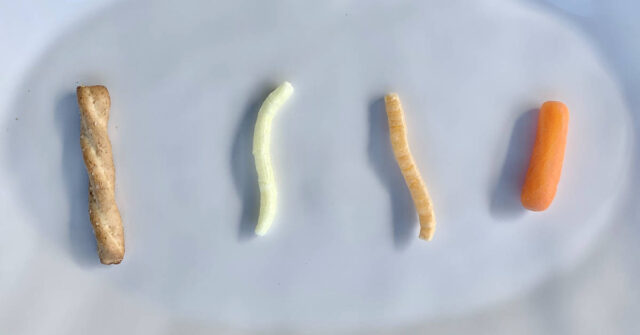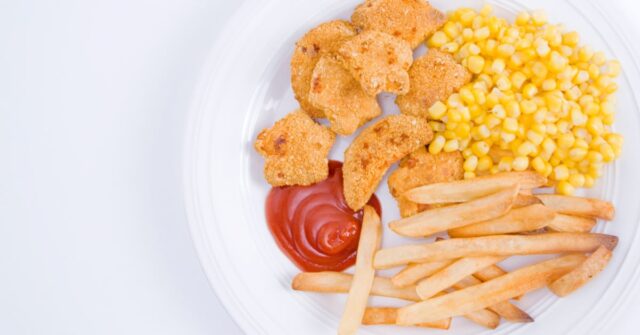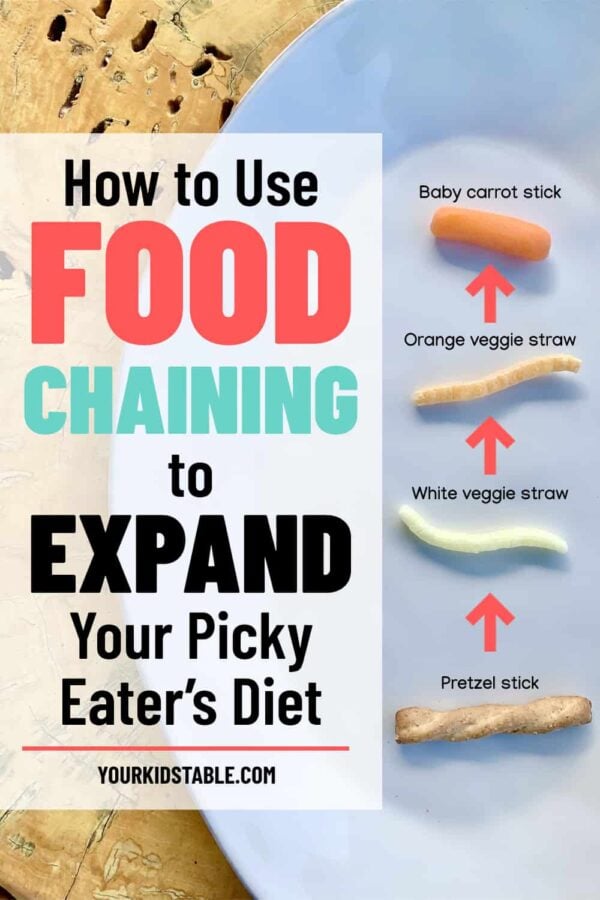What is food chaining? Get the answer and learn what ages it’s best for and how to use this effective feeding therapy strategy to help any kid, especially picky eaters, learn to eat new foods.
She posted a picture of lamb souvlaki, complete with cucumbers, tomatoes, feta, lamb, tzatziki sauce, and cucumbers. She said, “I would’ve laughed last year at thought of serving this to my kid.”
But, here he was gobbling it all up. One of the strategies that helped her son learn to eat the cucumbers and feta in particular was something called food chaining.
Have you heard of it?
What is Food Chaining?
Food chaining is a therapeutic strategy used by feeding therapists to increase the variety of foods a child is willing to eat. Basically, it’s a way to help picky eaters eat more foods. As an occupational therapist, I focus on the actual food chaining element of the strategy.
But, food chaining is an entire formalized plan that was primarily created by speech therapist’s Cheri Fraker and Laura Wilbert, they also coined the term.
In our picky eating program, Mealtime Works, I’ve adapted the strategy and it’s used in the fourth phase of our plan that helps kids overcome picky eating. If you’re a Mealtime Works student, you know it as the Building a Bridge strategy.
What Ages Does Food Chaining Work for?
One of the things I love the most about food chaining is that it can be incredibly effective for babies all the way through adulthood!
The reason it’s so successful is because it creates small manageable steps a child can take to slowly learn to taste, eat, and enjoy foods that are similar in some way to foods they already eat.
How Does Food Chaining Work?
Food chaining works by taking a food that your child is already eating and identifying new foods that they are similar in color, shape, texture, smell, or taste to serve them at meals.
The more alike the two foods are, the more likely a child is to eat it.
I often adapt food chaining to be very general. For instance, if your child loves chicken nuggets and other types of bread and carbs, but eats no other protein, then offering other breaded proteins like breaded fish nuggets or homemade breaded chicken nuggets is a great way to start working on new foods.
You can also use food chaining to make a large map of linking new foods together. You’re starting place on the map is always a food your child eats well. Let’s use a different example…

Let’s say your kid loves pretzels, but they refuse to eat a veggie of any sort. As you can see in the picture above, an example of the next food chaining step is offering white veggie straws, as they are similar in color and shape.
Once those are accepted and regularly eaten, you can then give them the orange veggie straws. They already like the white ones, the orange may have the slightest difference in taste.
When they eat the orange veggie straws too, you can then work on a bigger link to baby carrots or carrot sticks. Carrots are hard, crunchy, and stick shaped, but are cold, harder to chew, and have a different taste.
While my example in the picture stopped with raw carrots, you could also continue to build from them by linking to cooked baby carrots, then cooked carrots of different sizes and shapes.
It’s good to have this road map, but I always encourage Mealtime Works students to be ready to adapt and allow lots of detours, because your child might really struggle with a particular food and going in another direction and branching off into other new foods than you had originally planned for.
Like in the example above, you could have introduced raw orange bell peppers cut into slices or sweet potato fries instead of carrots. Or, you could work on those after the carrots.
Food Chaining is All About Connections
Even though I specialize in feeding difficulties in children and picky eating, I know as a parent, I’d just look at what my son wasn’t eating. I was making grilled chicken, pot roast, or salmon for dinner and I longed for him to eat it.
But, all those foods were such a huge leap from the types of food he was willing/able to eat. Food chaining builds a bridge to get to those foods you really want your child to eat one step at a time through links to food they’re already eating.
Using this strategy does require some planning and fore thought.

How You Can Start Using Food Chaining to Help Your Picky Eater
There are some simple ways that you can to start to use the concepts of food chaining in your own home. However, if you’re working with a feeding therapist and they aren’t using this strategy, ask them about incorporating it.
And, if you’re in Mealtime Works, you have the detailed video and written lesson in Module 4 that teaches you exactly how to use my adaption of this strategy in your home, as well as the 22 page Building a Bridge Strategy Guide printable that accompanies this lesson. We also encourage you to reach out in our private fb group and we’ll help you set up your map of linking foods together for your child if you need it.
Here’s 3 steps to getting started with food chaining:
1. Make a list of all your child’s foods.
Take a few minutes and identify any common themes you might see among these foods. Are most or all of the foods crunchy, white, stick shaped, soft, bland, spicy, etc.
While a lot of picky eaters do tend to select their foods because of the taste, texture, color, or smell, not all do. Sometimes it’s random. That’s okay, but if there is a trend, you can leverage that to your advantage.
2. Circle a few foods on the list that your child really likes and brainstorm some other foods that are similar in some way.
Try not to limit yourself here. Write down as many ideas as you can think of. Think of foods similar in color, texture, smell, or taste. If they have several similarities, they’re even more likely to actually eat those foods.
3. Start serving the most similar foods regularly during meals.
Depending on how severe of a picky eater your child is, they may just start to eat these highly similar foods with no other strategies or help from you. But, many extreme picky eaters usually need other strategies as well, like addressing the underlying cause (i.e.: sensory sensitivities, oral motor weakness) or direct strategies that help kids interact with new foods.
That’s why my adapted building a bridge strategy is one of several strategies taught as the fourth step in the Mealtime Works plan.
But, even without other strategies, getting these new foods onto your kid’s plate is progress, and they’re far more likely to eventually eat them. And, once they do, then you can work on another new food.
“Wait, I Need More Help!”
If your child is eating only a handful of foods, they flip out when anything new is on their plate, and you want specific examples of how to link the right foods together for your child, then I hope you’ll join me inside of Mealtime Works.
This week (Thursday, Oct. 21) our annual Mealtime Works mega sale and special bonuses like The Nutrition and Gut Health Mini Course for Picky Eaters and Live Support Package end at midnight.

As a student, you get access to the whole online program, which includes that 22 Page Building a Bridge Strategy Guide with lots of detailed examples and more steps for using this strategy well. You also get dozens of other printables to share with family, other caregivers, or families on your caseload (if you’re a therapist).
And, you get access to me and my team of OT’s daily to answer your questions!
Click here to join Mealtime Works today!
Alisha Grogan is a licensed occupational therapist and founder of Your Kid’s Table. She has over 17 years experience with expertise in sensory processing and feeding development in babies, toddlers, and children. Alisha also has 3 boys of her own at home. Learn more about her here.

What’s your programs current effectiveness with neurodivergent children? My son is an autistic 3 year old and mostly non speaking, and when using words he primarily does so through echolalia, which he seems to enjoy doing for stimming primarily over communicative purposes. So without confirmation from him and based off observation solely I’m concerned his “picky eating” restrictions stem from either neophobia or ARFID.
Hey Samantha!
Thanks for reaching out! We do have kids in our picky eating course diagnosed with Autism that still make progress. Our program does address the underlying cause which is often a missing piece when working with feeding. There is a lot of confusion between ARFID and the new diagnosis of PFD. Most kids are diagnosed with PFD (or fall into that category), in which our program does address all aspects of it. ARFID is purely a psychological based diagnosis, so if there is any medical underlying diagnosis they couldn’t fall into the ARFID category. Hope that helps some, if you have any other questions about our program, feel free to reach out.
Best,
Desiree
Your Kids Table Team Member
How do you get on the Facebook link???
Hey! We did just turn off access to our online mini course last week. I’m not sure if that’s what you’re asking for. If you’re looking for our Facebook Page, here’s the LINK. Please let us know if we can help you with anything else!
Best,
Andrea
Hey Alisha,
Although a few of your tips from the mini course have already worked for getting my picky eater to try 2 new foods, I’m still on the fence if this course will help us. Reason being is he was diagnosed with Dysfunctional Mood Dysregulation Disorder and Sensory Processing Disorder (the two feed off each other and one will escalate the other). Often times even when he likes a food that we’re having, he won’t eat it just because he doesn’t want it and expects us to cater to him. Does this program address any of these defiance issues?
Thanks so much 🙂
Hey Kristen,
Thanks for reaching out! We’d love to have you in our Mealtime Works program! The program definitely goes into tons of detail about sensory processing and how it’s related to picky eating- and what to do about it. We encourage remaining neutral about food and not praising or pressuring with foods. We give you lots of suggestions on how to make this happen for your family. Using this technique can go a long way in reducing defiance issues. We also have our private group where you are able to ask questions about your specific child and we are there to help you problem solve! Our mega sale for mealtime works with all the special bonuses ends tomorrow. Please reach out if you have any other questions!
Best,
Andrea